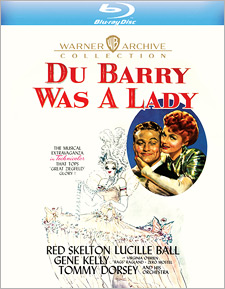Du Barry Was a Lady (Blu-ray Review)

Director
Roy Del RuthRelease Date(s)
1943 (July 25, 2023)Studio(s)
Metro-Goldwyn-Mayer (Warner Archive Collection)- Film/Program Grade: A-
- Video Grade: A
- Audio Grade: A
- Extras Grade: C
Review
Though MGM’s advertising played up Du Barry Was a Lady’s roots as a 1939 Cole Porter Broadway musical, their film version was almost nothing like the racy show. Thirteen of Porter’s 17 songs were jettisoned, as was most of the original book. The resultant film is nearly plotless, and yet most of the time what’s onscreen varies from pretty entertaining to spectacularly good.
The thin premise has both nightclub coatroom attendant Louis Blore (Red Skelton) and master of ceremonies/struggling songwriter Alec Howe (Gene Kelly) both in love with the swanky nightclub’s main attraction, singer May Daly (Lucille Ball). She admits to being in love with Alec but is determined to marry for money.
Conveniently, Louis wins $150,000 in the Irish Sweepstakes, and May reluctantly agrees to marry him. After a mix-up far too trivial and complicated to bother explaining here, Louis is knocked cold by a Mickey Finn, and the last third of the film has him dreaming that he’s King Louis XV. May becomes Madame Du Barry, Alec a Robin Hood-like “Black Arrow,” and just about everyone in the main story turns up here. That’s pretty much it as far as the film’s plot is concerned.
Where Du Barry Was a Lady delivers is as pure, extravagant wartime escapism; it’s easy to imagine 1943 audiences having a whale of a time watching this mishmash of a confectionery. It has everything: comedy courtesy Red Skelton and Zero Mostel (in his film debut), Rags Ragland and George Givot; glamour from Lucille Ball; acrobatic dancing from Gene Kelly; funny novelty singing from Virginia O’Brien; and top-notch big band jazz by Tommy Dorsey and His Orchestra, including Buddy Rich on the drums and the Pied Pipers doing vocals. Moreover, all of this is presented in eye-watering (three-strip) Technicolor.
The film, then, plays more like a big musical revue than a story- or character-driven movie musical, cycling through all of these musical and specialty acts every few minutes, nothing on so long as to wear out its welcome.
This was probably Lucille Ball’s best pre-I Love Lucy part in a feature film. She gradually rose up through the ranks at RKO, but by the late-1930s hit a brick wall, probably owing to the glut of talent there (Katharine Hepburn, Ginger Rogers, etc.) competing for leading roles. She moved over to MGM in the early ’40s, which must have seemed like a step up, but after Du Barry, the studio clearly had no idea what to do with her. She was glamorous but couldn’t sing (her singing voice is dubbed here with the exception of Friendship, a twangy song suited to her limitations), was not a particularly good dancer, and her talent for broad slapstick was still untapped. Reportedly Du Barry was the first time Ball dyed her hair a fiery red, which all but set nitrate Technicolor prints aflame. Nevertheless, she’s mostly window dressing.
Red gets to clown and Gene gets to dance, but the supporting players are more memorable this time out. Zero Mostel is such a loose cannon of comedy that even veteran movie bad guy Douglass Dumbrille can’t help but titter through the couple of scenes that pair them. Virginia O’Brien was a terrific wise-cracking best-friend-of-the-ingenue type, a kind of less-homely Mary Wickes, but also a terrific comic singer. Tommy Dorsey is so remembered for his lushly romantic theme song, I’m Getting Sentimental Over You, that it’s easy to forget just how hot his jazz band was in the ‘40s in response to criticism from purists in the late ‘30s. The film also captures Dorsey at the crossroads: crooner Frank Sinatra departed just prior to Du Barry and the Pied Pipers left immediately after.
One side note: The chorines in Du Barry are staggeringly gorgeous. Maybe it was Warner Archive’s restoration work, maybe MGM’s casting department had the pick of the litter, but whatever the case, the women featured in the big musical numbers are consistently knock-outs.
Photographed by Karl Freund (later to revolutionize the 3-camera sitcom with Ball’s I Love Lucy), Du Barry Was a Lady was photographed in three-strip Technicolor and Warner Archive’s restoration using the original nitrate black-and-white separation negatives results in a flawless presentation. The colors so “pop” here one could use any random scene as a demo of Technicolor at its peak. The DTS-HD Master Audio (2.0 mono) is also very good for an early-‘40s title, the Dorsey’s band’s numbers coming off unusually well. Optional English subtitles provided and, as with other recent Warner Archive musical titles, a “Song Selection” menu option is included.
Only the supplements disappoint, limited to a Barney Bear cartoon, Bah, Wilderness (7:16), and a trailer, both from standard-def sources.
MGM had a habit of buying the rights to popular Broadway musicals only to ditch 90% of their songs and stories, replacing them with homegrown material. Often this didn’t work, but the film of Du Barry Was a Lady is thoroughly delightful from start to finish and Highly Recommended.
- Stuart Galbraith IV

